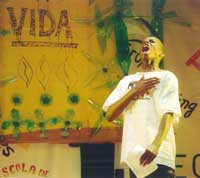 |
|
 |
 |
 |
 |
USAID Information:
External Links:
|
|
 |
 |
|
Creative Arts Lift Brazil's Youth
To a Better Education and Opportunity
The concentration, lightness and balance of the ballet dancers
dazzled the audience. Who would have thought that many of
the dancers from the Dance and Social Integration School for
Children and Adolescents (EDISCA)’s performance in Brasilia,
Brazil earlier this year had been at-risk children?
 The
event marked the ten year anniversary of USAID/Brazil’s
program to assist at-risk children and youth (Prevention Oriented
Towards At-Risk Children and Youth Program -- POMMAR), implemented
by Partners of the Americas. More than teaching ballet techniques,
EDISCA served as a creative outlet for children living in
the most impoverished neighborhoods of Fortaleza, offering
them positive exposure to activities promoting good health,
education, nutrition and the arts. The
event marked the ten year anniversary of USAID/Brazil’s
program to assist at-risk children and youth (Prevention Oriented
Towards At-Risk Children and Youth Program -- POMMAR), implemented
by Partners of the Americas. More than teaching ballet techniques,
EDISCA served as a creative outlet for children living in
the most impoverished neighborhoods of Fortaleza, offering
them positive exposure to activities promoting good health,
education, nutrition and the arts.
“We come here for ballet classes, computer lessons,
tutorial programs, rehearsals and lunch,” says Stefania
Pereira, 15, one of the teens who participates in EDISCA’s
core dance company.
The EDISCA program is one of 72 USAID/Brazil projects in
the past ten years that have provided technical and financial
support to creatively promote positive educational, family,
community, social, and economic incentives to girls and boys
who live amid extremely difficult circumstances. The program
targets youth who live on the streets or who have broken family
ties, victims of sexual abuse, exploitation and trafficking
for sexual purposes, child laborers, and school drop-outs.
With support from Displaced Children and Orphans’ Fund
(DCOF), the USAID/Brazil Mission views art-education as the
main conduit to attract and retain children in educational
activities.
Programs focus on education and job opportunity, and frequently
include activities to bridge the digital divide and eradicate
child labor; to prevent HIV/AIDS and assist AIDS orphans;
and to combat violence against children and youth, especially
sexual violence.
USAID invested $11 million during the past ten-years to directly
serve 35,000 children, and teens in poor areas of Northeast
Brazil and in the country’s capital, Brasília.
The projects extended beyond traditional assistance by investing
in the holistic development of children and adolescents. USAID
has encouraged youth to participate fully in the planning,
implementation and evaluation stages of the activities, in
addition to proactively intervene in their families, schools,
and communities.
Brazil’s sheer mass and its accompanying social and
economic problems were the incentive for the Mission to investigate
innovative solutions for the Government of Brazil to replicate.
The results have been positive. Ninety-eight percent of children
and teens receiving USAID assistance in the program are currently
enrolled in school and promptly promoted to the next school
grade, according to data collected last year. The data also
showed that 85 percent of adolescents completing USAID-supported
vocational education training programs have found legitimate
employment in the formal job market.
An example is Diosmar Filho, who came to the art-education
project Salvador, Bahia when he was 16 years.
“I was hired as an administrative assistant. It was
a dream for me and a reason for my family to be proud,”
he said. “I learned by following the example and working
with professionals in the areas of administration and education.
This was a key to my own professional development.”
Today Filho, 26, is one of the coordinators of this youth-serving
organization.
Richard Goughnour, mission director, said that USAID/Brazil
is currently transitioning to a new, six-year strategy that
will build on the POMMAR experience to design creative solutions
to offer a more promising future for Brazilian children and
youth.
View the photo gallery of
Brazil's youthful performers.
Back to Top ^ |


